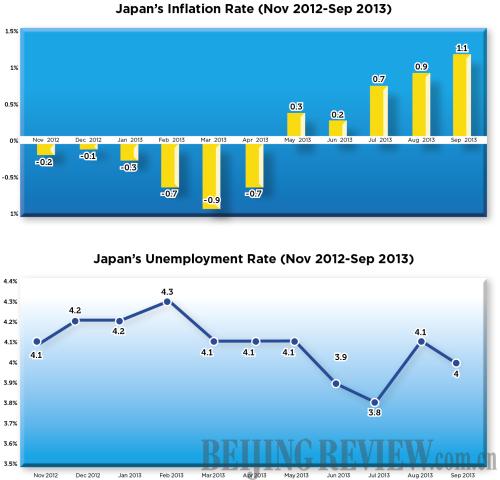|  Japanese Prime Minister Shinzo Abe has adopted a new method of treatment for the country's economic recession—known as Abenomics—since regaining the position in 2012. Japan's economy has indeed shown some progress, and the country's economic growth is expected to reach 2.6 to 2.8 percent in 2013. It's a positive achievement that comes at a time when developed economies struggle to address the aftermath of the global financial crisis. Japanese Prime Minister Shinzo Abe has adopted a new method of treatment for the country's economic recession—known as Abenomics—since regaining the position in 2012. Japan's economy has indeed shown some progress, and the country's economic growth is expected to reach 2.6 to 2.8 percent in 2013. It's a positive achievement that comes at a time when developed economies struggle to address the aftermath of the global financial crisis.
Japan's economic recovery will not be a bad thing for China or the global economy. With the current state of globalization, economic growth in the world's third biggest economy is certain to create more supply as well as demand. But it remains uncertain if the torch of Abenomics can guide Japan's economy out of its rut.
Abenomics refers to a series of economic stimulus measures Abe, who previously served as Japanese prime minister from 2006 to 2007, launched after he took office for the second time in late 2012. It focuses on more relaxed monetary policy and accelerated depreciation of the yen's exchange rate. The core of the program is known as the three "arrows": a bold financial policy, a relaxed fiscal policy and a growth strategy attracting non-governmental investment.
The first arrow is aimed at reaching the goal of 2 percent inflation within two years, adopting an unlimited quantitative easing policy, rectifying the trend of the yen's appreciation, and amending Japan's banking laws for better coordination with the government.
The second arrow emphasizes large-scale public investment and buying operations of construction bonds by the Bank of Japan, the country's central bank.
The third stresses negative interest rates, growth created by societal longevity and health, a growth strategy involving all citizens as well as an emphasis on youth and women in the workforce.
To push forward these policies, Abe made strong efforts including changing the governor of the Bank of Japan to Haruhiko Kuroda, a supporter of yen depreciation.
Japan's unemployment rate did not show much improvement from November 2012 to September 2013. However, compared with unemployment in the United States, which is 7 percent, and that of the European Union, which is over 10 percent, Japan's unemployment rate has stayed at a relatively low 4 percent. In the meantime, Japan's consumer price index has been rising since June 2013.
The stimulus package hasn't yet influenced the country's exports in an obvious way, which means the yen's depreciation is not encouraging export as expected. The reason is that the economic growth rate of emerging economies, including China, has been slowing down, which cuts down demand in these markets.
Challenges & opportunities
The success of Abenomics will depend on its long-term effects rather than the short term ones. It is not difficult to temporarily stimulate the economy, through quantitative easing for instance. but a long-term policy is different. The economy needs self-cycling, which demands that the market play a functional role. It requires activating the market's functions, such as investment opportunities. Enterprises will not invest unless there is an economic outlook. Profits will not be created without investment. Thus, employees will have lower incomes, consumption will shrink and product prices will fall. As a consequence, profits will decrease further. Abenomics, which claims to create an impetus to change this vicious cycle, is widely welcomed in Japan as a result.
The first two arrows of Abenomics will find hitting their targets easier than the third will. As the economy's biggest challenge is the lack of investment prospects, the third arrow might miss its mark.
As a highly developed country, Japan has few aspects to hold investment. The country's infrastructure facilities are already well developed. For instance, it has built 97 airports in a space as large as China's Yunnan Province, which covers about 380,000 square km. The domestic market is unattractive to Japanese enterprises due to high labor costs, they would rather invest in other countries to chase bigger profits. Moreover, the third arrow is hardly going to create opportunities for economic growth. Today's Japanese youth are rarely interested in studying and working in other countries because they believe Japan is the best country in the world. It is hard to image how such a generation can play a leading role on the world stage. Moreover, it will still be a long time before Japanese women can play a practical role, considering the country's tradition of married women staying at home.
The sluggish world economy will continue to influence Japanese enterprises' investments overseas. Economic recovery must come before these enterprises can make the decision to expand their foreign investment. In this way, it will be impossible to realize a growth strategy of total involvement of society. Furthermore, the investment environment isn't always stable in Japan. For example, a tense China-Japan relationship has exerted a negative influence on Japan's investment in China.
Abenomics is still actively reviving the Japanese economy at a time when the global economy remains fragile and there is no silver bullet to take down the monster that is the economic crisis. Other countries are showing more encouragement than criticism over Japan's policies, even when it goes too far. An obvious example is that in the past, purposeful currency depreciation was usually criticized as government intervention in the market, but Japan's policy has gained approval in spite of this.
Japan is paying special attention to new markets. It has recently focused on the Mekong River Basin area, which covers Laos, Myanmar, Thailand and Viet Nam. The saturation of U.S. and European markets and the tension with its East Asian neighbors have led Japan to explore this new market. The area is more attractive than Central Asia, South Asia and Africa due to cheaper labor, ample resources, a huge potential market and similar cultural circumstances.
As a rule, it is almost impossible for a highly developed economy like Japan to sustain an economic growth rate higher than 2-3 percent. Developed countries' economic performance during the past 20 years suggests the difficulty of achieving such a feat. Europe and Japan have not yet surpassed 3 percent, while the U.S. economy realized a growth rate of 4-5 percent during the mid-1990s.
China's economic development will also influence Japan, as the former is going to provide opportunities for the latter. Japan invested $5.94 billion from January to September 2013 in China, making it China's second biggest investor. Japan's investment in the Mekong River area will bring the country potential new markets, cheap resources and energy, and fierce competition as well.
The international political situation and regional tensions are unfavorable to Japan at the moment. Economic development demands a peaceful and stable environment, but Japan's relationships with China and South Korea have been very tense. It is not easy to change this in the short term. Abe's rightward political shift may tip the scales in favor of China and South Korea, becoming a thorn in the side of his administration.
The author is a professor with the School of Economics, Renmin University of China
Email us at: yanwei@bjreview.com

| 